State Claims Agency
The SCA manages claims brought against the State. It also provides risk management services, advising and assisting State authorities in minimising their claims exposure.
Managing a Complex and Diverse Claims Portfolio
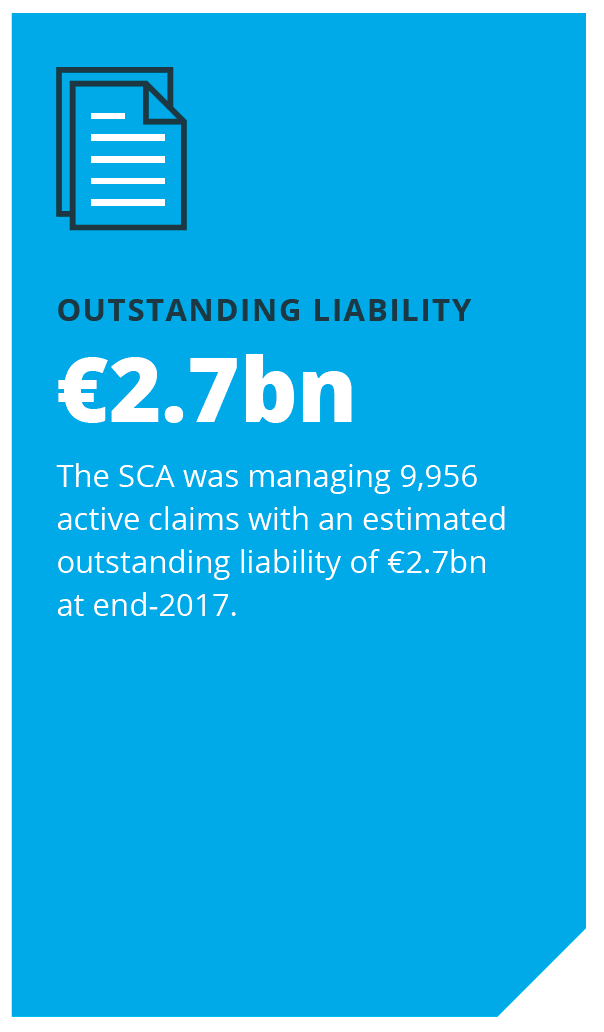
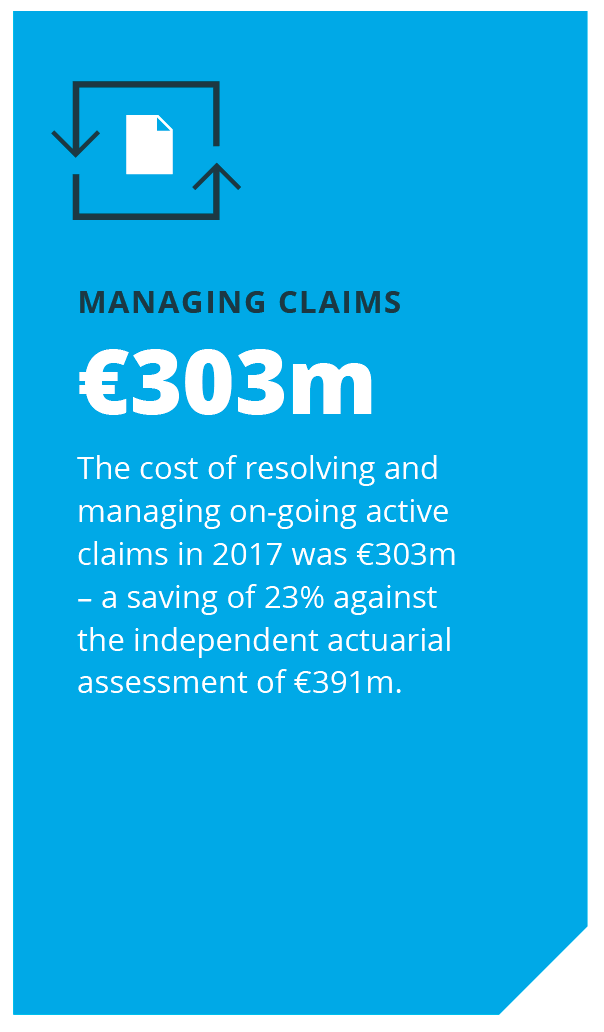
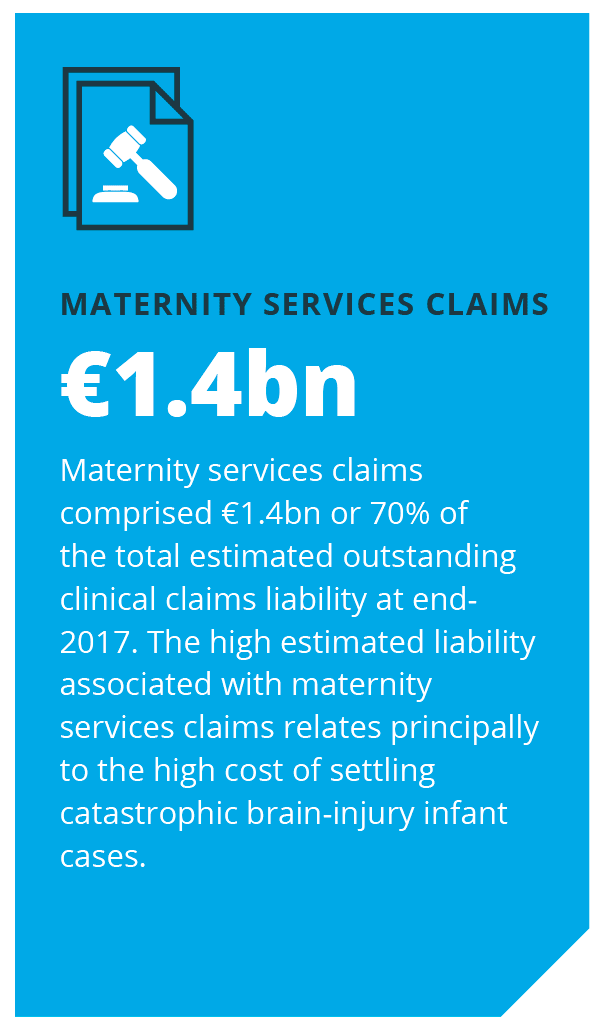
Reducing Legal Costs
| In 2017, the SCA settled 440 bills of costs received from third parties for €55.2m – a reduction of 48% on the €106.9m claimed. |
Enhancing Risk Management
| During 2017, the SCA continued the roll-out of NIMS – a single ICT system to support the management of risk across its public service, including the healthcare sector – across State authorities. The total number of active users increased to approximately 2,000 from 800 at end-2016. |
The NTMA is designated as the State Claims Agency (SCA) when managing claims against the State and State authorities and carrying out related risk management functions in order to reduce the costs of future litigation against the State.
The SCA’s remit covers personal injury and third-party property damage risks and claims relating to 146 State authorities including the State itself, Government Ministers, the Attorney General, the Health Service Executive, the voluntary healthcare sector, An Garda Síochána, the Irish Prison Service, the Defence Forces and community and comprehensive schools. The SCA’s Legal Costs unit manages third-party costs arising from certain Tribunals of Inquiry and claims for legal costs by parties who have successfully sued the State in respect of personal injury and other non-personal injury related actions.
CLAIMS AND LITIGATION MANAGEMENT
The SCA’s claims management objective is, while acting in the best interest of taxpayers in matters of personal injury and property damage litigation, to act fairly and ethically in its dealings with people who have suffered injuries and/or damage and who take legal actions against the State or State bodies, and their families. In cases where the SCA investigation concludes that the relevant State authority bears some or all liability, it seeks to settle claims expeditiously and on fair and reasonable terms. If it considers, in individual claims or classes of claim, that the State is not liable, the SCA’s policy is to defend those claims.
Active Claims
The SCA managed 9,956 active claims with an estimated outstanding liability of €2.7bn at end-2017.
Active Claims at End-2017
| Claims |
Estimated Outstanding Liability €m |
|
|---|---|---|
| Clinical | 2,976 | 1,984 |
| General | 6,980 | 679 |
| Total | 9,956 | 2,662 |
Maternity services claims comprised €1.4bn or 70% of the total estimated outstanding clinical claims liability at end-2017. The high estimated liability associated with maternity services claims relates principally to the high cost of settling catastrophic brain-injury infant cases.
The total estimated outstanding liability of €2.7bn takes account of the Court of Appeal Decision in Gill Russell v HSE. The Court of Appeal held that the Real Rate of Return (RRR) in respect of the calculation of future care-related special damages should be 1%. It also held that the RRR in respect of all pecuniary losses should be 1.5%. The RRR used previously to calculate the estimated outstanding liability was 3%. Arising from the Court of Appeal Decision, the SCA paid “catch up” payments totalling €25m during 2017. These payments were made in respect of catastrophic injury cases, not fully resolved, where settlement had originally been agreed on a lump sum basis or by way of interim Payment Order for a defined period of time at the prevailing 3% RRR prior to the Court of Appeal decision. These cases, therefore, required to be adjusted for the effect of the lower rate by the payment of additional compensation.
Breakdown of Estimated Outstanding Liability for Active Claims at End-2017
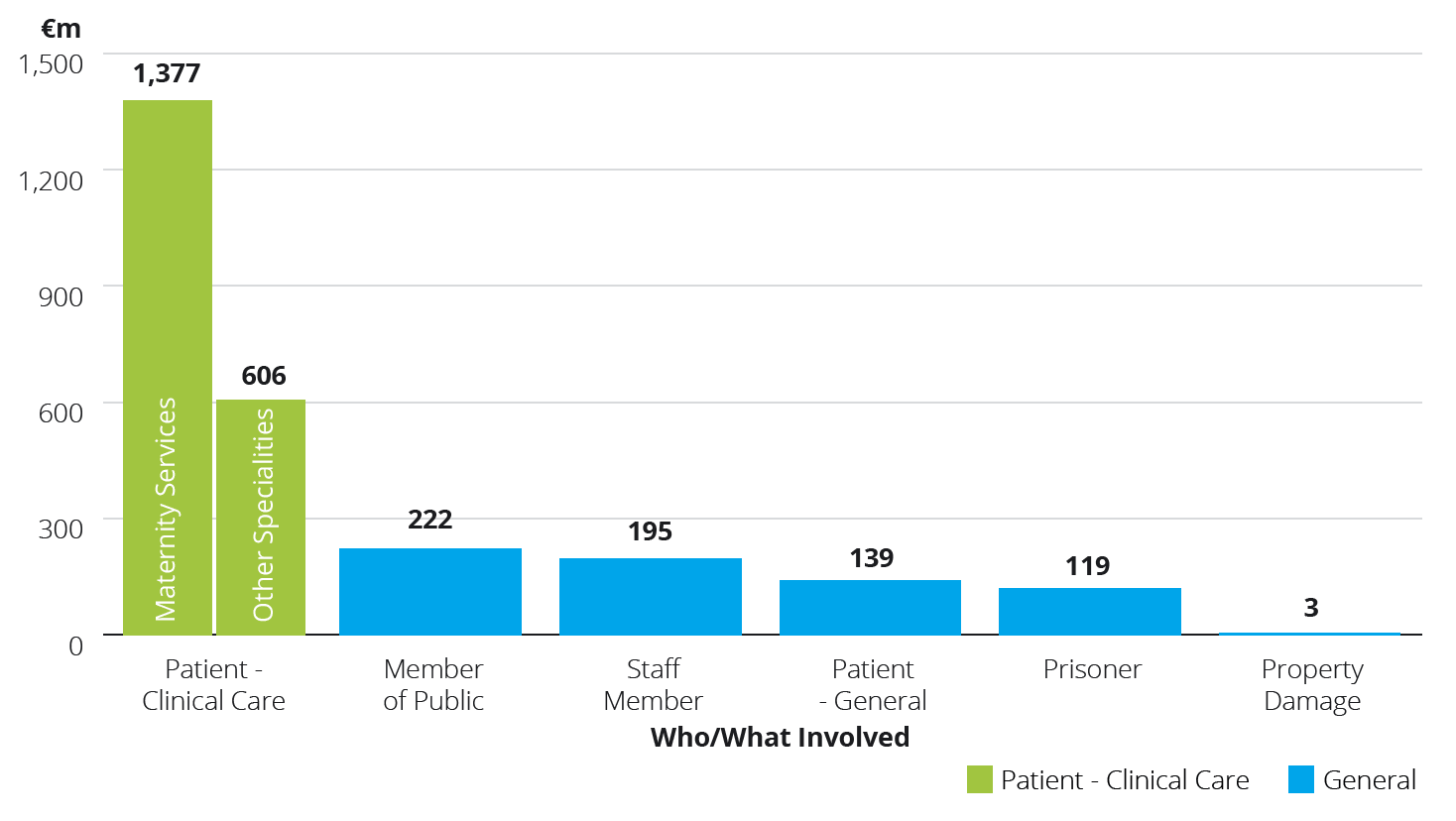
Figures may not total due to rounding.
The SCA received 3,259 claims and resolved 2,233 claims in 2017. There was an increase in the volume of new general claims received, driven in part by mass action claims and also by an expansion in the SCA’s remit with the delegation of the management of claims relating to organisations in the voluntary disability sector to the SCA. By contrast, the volume of new clinical claims has remained relatively constant.
Clinical and General Claims Received 2013-2017
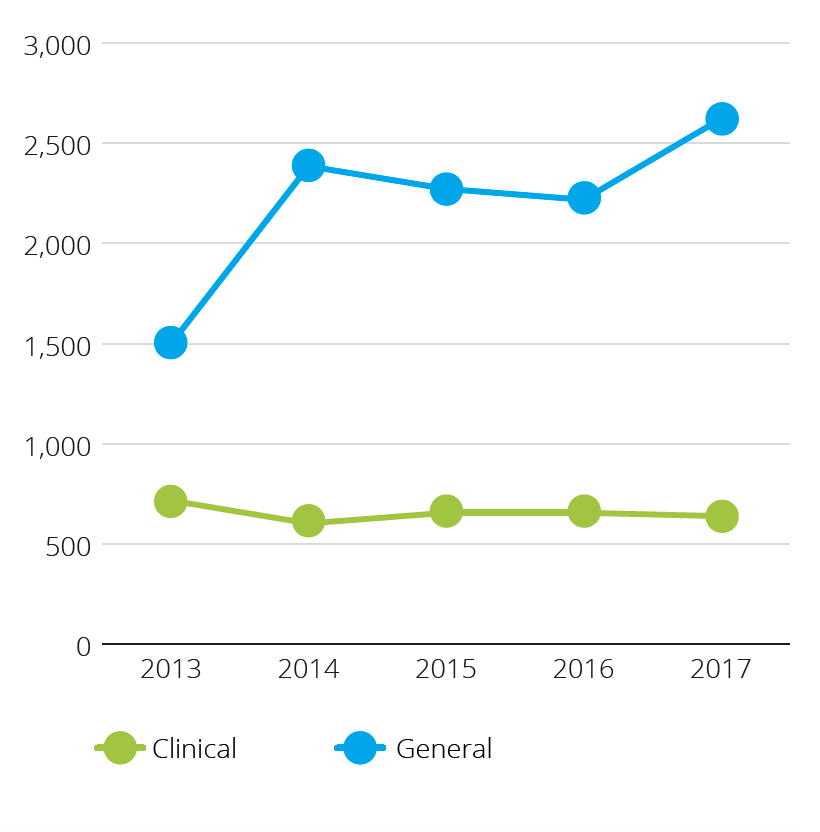
The cost of resolving and managing on-going active claims in 2017 was €303.2m compared with €251.5m in 2016. The 2017 out-turn represents a saving of 23% against the independent actuarial assessment of €391.1m.
Resolving Clinical Claims
The SCA resolves the majority of claims by negotiating a settlement, either directly with the plaintiff’s legal advisors or through a process of mediation: 98% of clinical negligence cases handled by the SCA are settled without the necessity for a contested court hearing.
Statutory Reforms concerning the Resolution of Clinical Claims
The Legal Services Regulation Act 2015 included three significant provisions to assist in the management of clinical negligence cases and reduce the number of cases that go to trial. These were:
- Provision for Ministerial power to make regulations for Pre-Action Protocols to facilitate timely communication between plaintiff and defendant and early identification of issues in dispute and to encourage early settlement;
- Provision that an apology by a medical practitioner does not constitute an admission of liability; and
- The Statute of Limitations period for the making of a clinical claim was increased from two to three years from the date of incident giving rise to the claim or the date of knowledge (if later).
It is expected that the regulations for Pre-Action Protocols will be introduced for medical negligence cases in 2018. This is likely to dramatically reduce the timeline between the receipt of and settlement of medical negligence cases and will also remove the more adversarial elements of the Tort system as it applies to medical negligence cases.
Clinical Claims Resolved 2013-2017 by Case Outcome
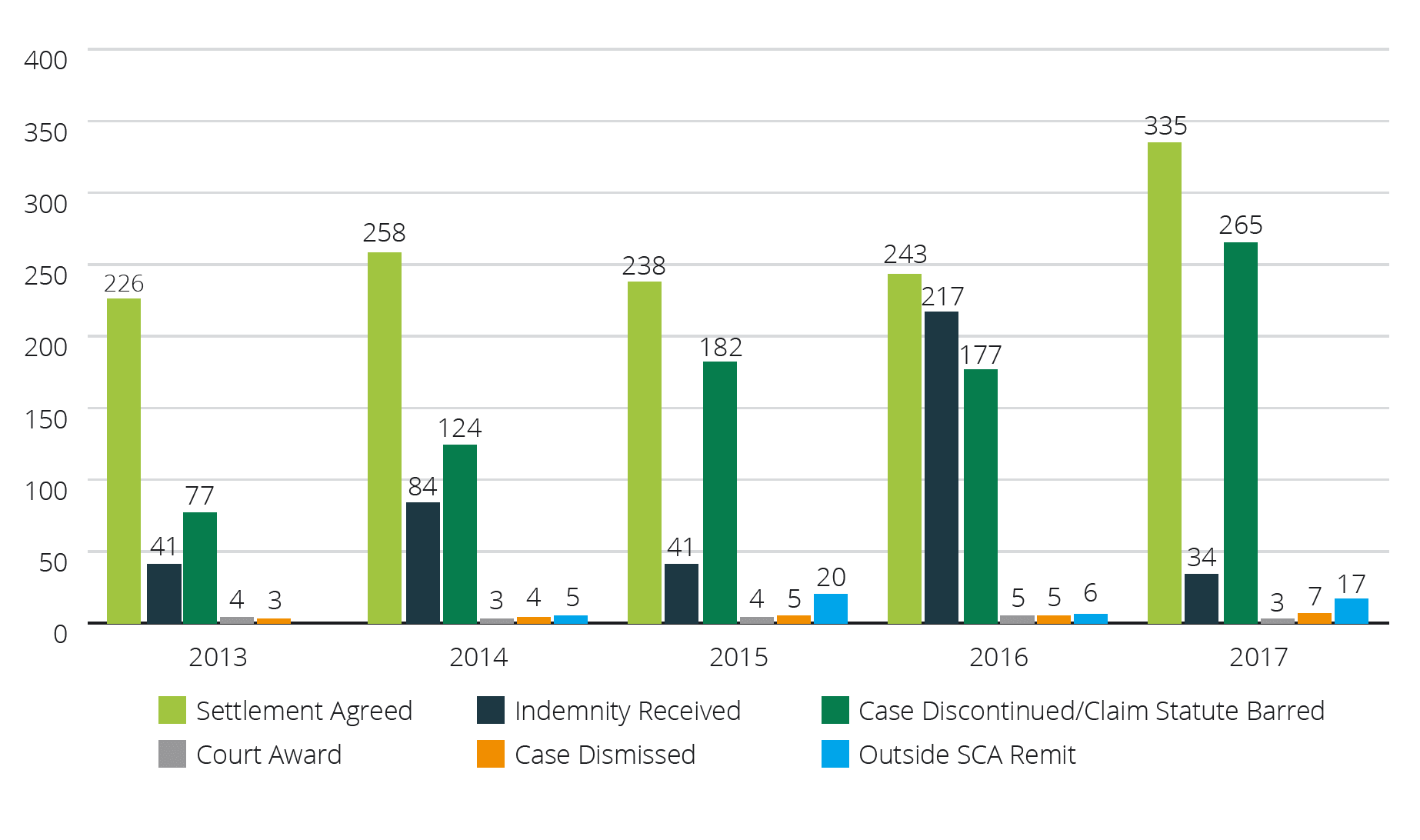
The Civil Liability (Amendment) Act 2017 when it is commenced, will empower the courts, as an alternative to lump sum awards of damages, to make consensual and non-consensual Periodic Payment Orders to compensate injured victims in cases of catastrophic injury where long-term permanent care would be required. This will be of considerable importance to families of catastrophically brain-injured infants and adults whose injuries occurred as a result of a clinical negligence event. The introduction of Periodic Payment Orders (PPOs) guarantees that catastrophically injured victims will receive annual fixed payments in respect of care and aids and appliances thereby removing their families’ worries associated with the investment of a lump-sum that it might run out prior to the plaintiff’s estimated life expectancy.
Cost of Claims Resolved
Awards/settlements in respect of resolved clinical claims increased by 58% in 2017 when compared with 2016. This is principally due to the effects of catastrophic injury cases which previously settled by interim Payment Orders converting to lump-sum settlements. When these conversions are excluded, the underlying percentage increase compared with 2016 is 23%. This is principally due to the greater number of more serious claims being settled, having regard to the ageing effect of the portfolio.
Awards/settlements in respect of resolved general claims increased by 4% in 2017 when compared with 2016.
Cost of Claims Resolved 2013-2017
| Clinical Claims | 2013 €000 |
2014 €000 |
2015 €000 |
2016 €000 |
2017 €000 |
|---|---|---|---|---|---|
| Cost for All Claims Resolved | |||||
| Awards/Settlements | 35,979 | 44,622 | 45,493 | 54,494 | 86,222 |
| Legal Fees – SCA | 9,506 | 8,845 | 9,222 | 8,740 | 15,076 |
| Legal Fees – Plaintiff | 15,427 | 13,803 | 15,985 | 17,653 | 26,825 |
| Other | 1,248 | 1,176 | 1,624 | 1,708 | 2,784 |
| Total | 62,161 | 68,446 | 72,324 | 82,594 | 130,908 |
| Average Cost per Claim Resolved | |||||
| Average Awards/Settlements | 103 | 93 | 93 | 83 | 130 |
| Legal Fees – SCA | 27 | 19 | 19 | 13 | 23 |
| Legal Fees – Plaintiff | 44 | 29 | 33 | 27 | 41 |
| Other | 4 | 2 | 3 | 3 | 4 |
| Overall Average | 177 | 143 | 148 | 126 | 198 |
| General Claims | 2013 €000 |
2014 €000 |
2015 €000 |
2016 €000 |
2017 €000 |
|---|---|---|---|---|---|
| Cost for All Claims Resolved | |||||
| Average Awards/Settlements | 11,249 | 16,161 | 17,195 | 23,657 | 24,715 |
| Legal Fees – SCA | 2,943 | 3,170 | 3,674 | 4,505 | 4,602 |
| Legal Fees – Plaintiff | 4,310 | 5,742 | 6,276 | 8,478 | 9,021 |
| Other | 827 | 881 | 1,017 | 1,233 | 1,312 |
| Total | 19,329 | 25,955 | 28,162 | 37,873 | 39,651 |
| Average Cost per Claim Resolved | |||||
| Average Awards/Settlements | 8 | 11 | 13 | 15 | 16 |
| Legal Fees – SCA | 2 | 2 | 3 | 3 | 3 |
| Legal Fees – Plaintiff | 3 | 4 | 5 | 5 | 6 |
| Other | 1 | 1 | 1 | 1 | 1 |
| Overall Average | 13 | 18 | 21 | 23 | 25 |
Mass Actions
The SCA is managing a number of different mass actions against the State. Each mass action is managed by reference to a specific legal strategy, while acting fairly and ethically in dealing with people who have suffered injuries and/or damage and their families.
Active Mass Action Claims
| Mass Action | Active End-2017 |
Received 2017 |
Finalised 2017 |
|---|---|---|---|
In-Cell Sanitation These are cases taken by prisoners (current and former) against the Irish Prison Service alleging, inter alia, breach of their constitutional rights due to lack of in-cell sanitation. |
1,635 |
364 |
1 |
Day School Abuse These are cases taken by persons who allege they were physically and/or sexually abused by persons whilst at school. Most of the cases were initiated following the ECHR Judgment in Louise O’Keeffe v Ireland. |
146 |
9 |
29 |
Shine Abuse Claims These are cases taken by persons who allege they were sexually assaulted by former consultant surgeon, Michael Shine, while they were patients in Our Lady of Lourdes Hospital, Drogheda and/or attending him at his private clinic. |
92 |
90 |
0 |
Pandemrix/Narcolepsy These are cases taken by mostly infant plaintiffs alleging the development of narcolepsy and cataplexy following vaccination against the H1N1 flu virus. |
70 |
18 |
0 |
Prison-Based TB These are cases taken by current and former prisoners and prison officers alleging testing positive for and/or contracting TB. |
63 |
5 |
23 |
Lariam These are cases taken by current and former members of the Defence Forces, alleging severe psychosis type symptoms, following their ingestion of Lariam, an anti-malarial prophylactic drug prescribed for their use whilst on duty in sub-Saharan Africa. |
47 |
7 |
4 |
Symphysiotomy These are cases taken by women who had a surgical, obstetrical procedure to widen their pelvis. |
35 |
0 |
95 |
Thalidomide These are cases taken by persons born with physical disabilities whose mothers had ingested the Thalidomide preparation during pregnancy. |
34 |
0 |
0 |
Metal-on-Metal Orthopaedic Implants These are cases taken by persons alleging personal injury having been surgically fitted with orthopaedic hip implants. |
22 |
6 |
14 |
SCA CASE OF PRECEDENCE 2017
ISABELLE SHEEHAN, A MINOR V DAVID CORR
A landmark ruling was delivered by the Supreme Court on 15 June 2017 clarifying the jurisdiction and methodology of the Taxing Master of the High Court in the assessment of solicitors’ and counsels’ fees. The case involved a review of the Taxing Master's decision to reduce the solicitor’s general instructions’ fees to €276,000 (down from €475,000 charged) in a catastrophic injuries case in respect of which the State Claims Agency provided indemnity for the costs incurred. The substantial reductions achieved on the Taxing Master’s taxation of costs were affirmed by the President of the High Court by order of 6 March 2015.
The Court of Appeal disagreed and ordered a new taxation procedure with a move towards time-costing analysis as the foundation stone. Leave to appeal to the Supreme Court was granted and the Defendants’ Appeal was supported by the Law Society and Bar of Ireland who were joined as amici curiae for the purpose of the appeal. The Supreme Court delivered a comprehensive judgment vacating the Court of Appeal order and holding, inter alia, that as a general proposition, the amount of time actually spent on a case should not be elevated above other relevant criteria provided for in the Rules of the Superior Courts. It was noted that the taxation of costs process had never before been canvassed to such extraordinary length and detail. The Supreme Court remitted the solicitor’s costs for further taxation and provided important clarity and guidance as to the process to be applied in the proper scrutiny and assessment of solicitors’ professional fees.
LEGAL COSTS UNIT
A Legal Costs Unit (LCU) was established within the SCA in 2013 to deal with third-party costs arising from certain Tribunals of Inquiry (the Mahon, Moriarty, Morris and Smithwick Tribunals). In 2015, the Government extended the LCU’s responsibilities to management of all legal costs claims against the State.
The level of legal costs paid to plaintiffs’ legal representatives is carefully examined and, wherever possible and by means of negotiations, the SCA seeks to achieve the maximum possible reduction in legal costs. If the SCA cannot successfully agree the level of legal costs to be paid to plaintiffs’ legal representatives, the matter is determined by a Taxing Master.
In 2017, the SCA settled 440 bills of costs. The total amount claimed was €106.9m. These bills were settled for €55.2m – a reduction of 48% on the amount claimed. All of these claims were agreed without the necessity for taxation, thus avoiding delays in settlements and stamp duty charges at 8% of the taxed award.
Legal Costs Claims Settled 2017
| Number of Cost Claims Negotiated |
Amount Claimed €m |
Cost Claims Agreed €m |
Legal Cost Saving % |
|
|---|---|---|---|---|
| SCA Clinical | 156 | 37.2 | 21.9 | 41 |
| SCA General | 110 | 6.2 | 4.2 | 33 |
| Mahon Tribunal | 40 | 28.7 | 10.9 | 62 |
| Moriarty Tribunal | 9 | 11.8 | 5.7 | 52 |
| Morris Tribunal | 2 | 1.2 | 0.6 | 53 |
| Referred by Chief State Solicitor’s Office | 123 | 21.7 | 12.0 | 45 |
| Total | 440 | 106.9 | 55.2 | 48 |
| Figures may not total due to rounding. | ||||
RISK MANAGEMENT
The SCA’s risk management objective is to implement targeted personal injury and property damage risk work programmes to mitigate litigation risk in State authorities and healthcare enterprises, in order to reduce the costs of future litigation against the State. The “risk universe” indemnified by the State and managed by the SCA is extensive. For example, it includes over 200,000 State employees and all public healthcare service users (public healthcare has approximately seven million contacts with members of the public per annum). It also includes public services that, by their nature, constitute higher risk activities such as the provision of clinical care in hospitals, Defence Forces personnel on operations overseas, members of An Garda Síochána on operational duty, customs inspections, emergency response services and custody of prisoners.
The SCA’s clinical risk management programme focuses on collaboration with risk managers and other personnel in healthcare enterprises to support patient safety. The enterprise risk management programme focuses on providing advice and support to State authorities and healthcare enterprises in relation to risk management structures, maintenance of buildings, fire safety, health and safety, and environmental management.
Clinical Risk
The Clinical Risk Unit continued to support and monitor healthcare enterprises during 2017, tracking clinical incidents and providing support to clinical risk management teams, including regular site visits.
Significant clinical risk management activities in 2017 included:
- The publication of National Clinical Incidents, Claims and Costs Report: lessons learned, a five year review: 2010-2014. This provided an analysis of adverse incidents, clinical claims and associated costs over a five-year period;
- The publication of Review of Medication Incidents Reported in Irish Hospitals, based on a review undertaken in 2016; and the publication of a Patient Safety Notifi cation for healthcare enterprises highlighting the critical issues identified in the report;
- The hosting of the Second Annual National Quality, Patient Safety and Clinical Risk Conference in Dublin Castle featuring Irish and international speakers; and
- Ongoing clinical risk management programmes including Open Disclosure (which has to date resulted in the training of 20,000 healthcare staff , 400 trainers, and the delivery of 4,300 workshops) and the Affinity Falls Prevention and Bone Health Programme. Both of these programmes are delivered in collaboration with the HSE.
Enterprise Risk
Each year, the SCA devises a risk management works programme to assist State authorities with the development and implementation of risk management policies and procedures. Significant enterprise risk management activities in 2017 included:
- A comprehensive programme of audits and audit reports. While all major State authorities were addressed in the audits, there was a particular focus on the healthcare and educational sectors. In addition to enterprise level reports, ‘key national lessons learned reports’ were compiled and provided to all of the sectors which had been audited;
- In March 2017, the Work Positive Critical Incident framework (WorkPositiveCI) developed by the SCA in collaboration with the Health and Safety Authority (HSA) and Critical Incident Stress Management (CISM) Network Ireland was launched. WorkPositiveCI is a stress audit tool to assist organisations to meet the requirements of the HSA’s risk assessment for psychosocial hazards’ requirements arising from work-related stress. In recognition of the innovative nature of the framework, the SCA was invited to present a paper on WorkPositiveCI at the International Critical Incident Foundation’s 14th World Congress on Stress, Trauma and Coping. Since its launch, over 700 bodies have registered on the WorkPositiveCI website; and
- The inaugural SCA Enterprise Risk Recognition Awards ceremony for State Authority Network members was held in 2017. The awards acknowledged the work of State bodies in the area of enterprise risk management and commended the ongoing process of continuous improvement and progress in the management of risk across the State sector.
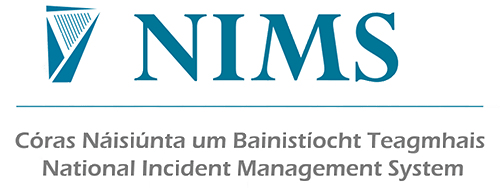
The SCA launched the National Incident Management System (NIMS), the successor to the former STARSWeb system, in June 2014. NIMS is a confidential, highly secure web-based system. It is an end-to-end risk management tool that allows enterprises to manage incidents throughout the incident lifecycle. This includes:
- Reporting of incidents (including Serious Reportable Events);
- Management of investigations;
- Recording of investigation conclusions;
- Recording of recommendations;
- Tracking recommendations to closure; and
- Analysis of incident, investigation and recommendations data and other functionality.
NIMS provides State authorities’ risk managers and the SCA’s own risk experts with complex adverse incident data analysis to identify trends, hot spots and lessons learned, thus enabling risk management and mitigation responses that will both ensure the safety of service users, patients and State employees and ultimately reduce the cost of claims against the State in the future.
In 2017, the SCA continued the roll-out of NIMS across State authorities. During 2017, 173,000 incidents were recorded, representing an 8% increase on the previous year while the total number of active users increased to approximately 2,000 from 800 at end-2016. One hundred key management information reports were developed for higher-risk State authorities while NIMS itself was significantly enhanced.
In 2017, the SCA delivered a NIMS Aftercare Strategy, with the objective of increasing incident reporting and highlighting the other benefits NIMS has to offer. This included:
- New self-service ‘Reporting at the Click of a Button’;
- The development of a NIMS eLearning module;
- Bespoke quarterly reports for each State Authority including KPIs on reporting performance;
- Specifi c focus on incident reporting during audits including, if required, one-on-one training with NIMS users; and
- Improvements to reporting methods and NIMS system.
In response to users’ requests, the SCA continues to enrich the functionality available on the system including the implementation of new incident review and investigation screens and electronic point of occurrence reporting. The SCA also commenced a major project to upgrade the system which will be completed in mid-2018. This will deliver significant cybersecurity benefits and next generation enhanced functionality.
